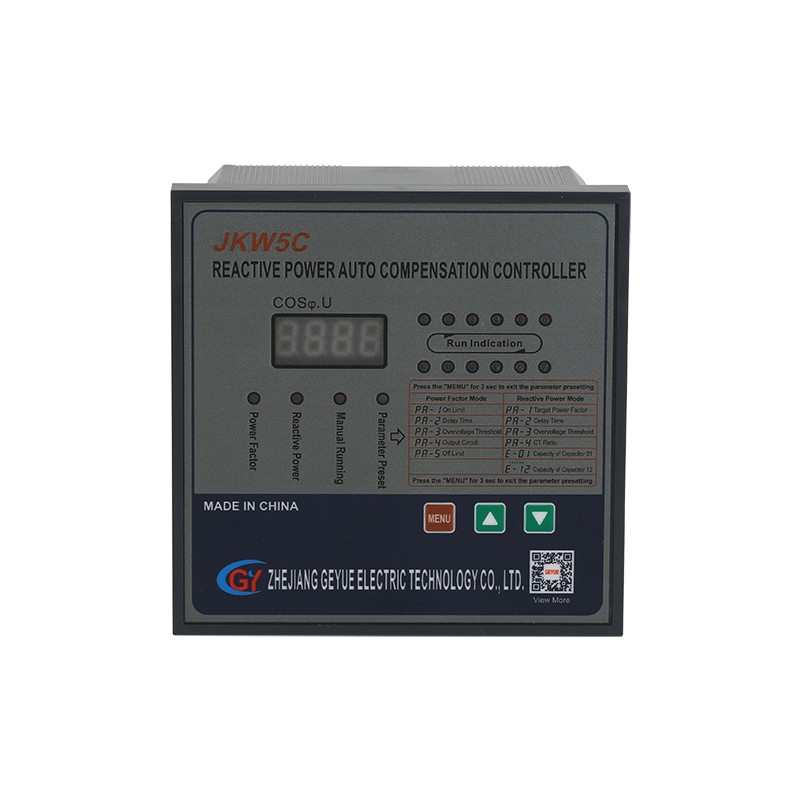Automatic Power Factor Controller: Enhancing Efficiency in Electrical Systems
2025-04-01
In today’s industrial and commercial environments, maintaining energy efficiency is more crucial than ever. Power consumption is a significant cost factor for businesses, and optimizing energy use can lead to substantial savings. One essential tool in managing power quality is the Automatic Power Factor Controller (APFC). This device plays a vital role in improving the power factor of electrical systems, ensuring that energy is used more efficiently, and minimizing electricity costs. In this blog, we will explore what an APFC is, how it works, its benefits, and why it’s essential in modern electrical systems.
What is an Automatic Power Factor Controller?
An Automatic Power Factor Controller (APFC) is a device used to automatically regulate and optimize the power factor in electrical systems. Power factor is the ratio of real power (the power that performs useful work) to apparent power (the total power supplied by the grid), and it is a critical aspect of electrical energy management.
When the power factor of a system is low, it means that the electrical system is not using power efficiently, leading to increased losses and unnecessary strain on the electrical grid. The APFC continuously monitors and adjusts the power factor by controlling the switching of capacitors or other reactive power compensation devices in the system. By doing so, the APFC ensures that the power factor remains within an optimal range, improving energy efficiency and reducing waste.
How Does an Automatic Power Factor Controller Work?
The main function of an APFC is to adjust the amount of reactive power in the system to achieve an optimal power factor, typically close to 1, which represents perfect efficiency. This is accomplished through the automatic switching of capacitors in and out of the circuit.
Here’s a simplified overview of how the APFC works:
1. Monitoring Power Factor: The APFC continuously monitors the power factor of the electrical system. It assesses whether the system is running at an optimal power factor or if there is a need for corrective action.
2. Calculating Required Compensation: When the APFC detects that the power factor is falling below the desired threshold (usually 0.95 or 0.98), it calculates the amount of reactive power that needs to be added or removed to bring the system back into balance.
3. Switching Capacitors: Based on the calculations, the APFC automatically switches the appropriate capacitors on or off. Capacitors supply reactive power to the system, helping to offset the inductive loads that typically cause low power factor. By controlling the number of capacitors in the circuit, the APFC ensures the power factor is corrected efficiently.
4. Continuous Adjustment: As the electrical load on the system changes, the APFC adjusts the capacitor banks in real-time to keep the power factor within the optimal range. This continuous adjustment ensures that the system is always operating efficiently.
Benefits of Using an Automatic Power Factor Controller
The use of an APFC offers numerous advantages, both in terms of energy savings and operational efficiency. Let’s take a closer look at some of the key benefits:
1. Improved Energy Efficiency
The most significant advantage of using an APFC is the improvement in energy efficiency. By optimizing the power factor, the system uses energy more effectively, reducing losses due to reactive power. This leads to lower energy consumption, which in turn reduces electricity bills.
2. Reduced Electricity Bills
A low power factor is often penalized by utility companies, meaning businesses may have to pay additional charges. By maintaining a high power factor, an APFC helps avoid these penalties, resulting in reduced electricity bills. In some cases, the savings on electricity costs can be substantial, especially for large industrial or commercial operations.
3. Increased Equipment Longevity
When the power factor is optimized, the overall load on electrical equipment is reduced. This reduces the strain on motors, transformers, and other components, leading to a longer lifespan for these assets. The APFC helps ensure that electrical equipment operates within its rated parameters, preventing overheating and damage that can occur from inefficient power use.
4. Improved Voltage Stability
An optimized power factor can improve the overall voltage stability of the electrical system. This is particularly important in industrial environments where voltage fluctuations can affect the performance of sensitive machinery. By reducing reactive power, the APFC helps maintain a steady voltage level, ensuring smoother operation and reducing the risk of equipment malfunction or failure.
5. Better Power Quality
Maintaining a high power factor improves the overall quality of power in the system. This is especially important in industries that rely on precise electrical operations, such as in manufacturing, telecommunications, and data centers. The APFC ensures that power quality remains consistent, reducing the likelihood of disruptions or downtime caused by power quality issues.
Applications of Automatic Power Factor Controllers
APFCs are used in a wide range of industries and applications where power quality and efficiency are essential. Some of the most common applications include:
1. Industrial and Manufacturing Plants
In large industrial and manufacturing facilities, machines such as motors, transformers, and induction furnaces often cause a low power factor due to their inductive nature. An APFC is crucial in these settings, as it helps to maintain an optimal power factor, improving energy efficiency and reducing operational costs.
2. Commercial Buildings
Commercial buildings, such as shopping malls, office complexes, and hospitals, often use large amounts of electrical power for lighting, HVAC systems, and other equipment. An APFC helps these buildings manage their power factor, minimizing electricity bills and improving energy use.
3. Data Centers
Data centers require reliable and efficient power to run their servers and other critical systems. The use of an APFC helps to ensure that the power supply remains stable and efficient, preventing power issues that could lead to data loss or system downtime.
4. Utility Companies
Utility companies use APFCs in their substations and other infrastructure to improve the overall efficiency of the electrical grid. By correcting power factor imbalances, APFCs help reduce transmission losses and ensure that electricity is delivered efficiently to consumers.
Conclusion
An Automatic Power Factor Controller (APFC) is a critical device for improving the efficiency and reliability of electrical systems. By automatically monitoring and correcting the power factor, the APFC helps businesses and industries reduce energy waste, lower electricity costs, and extend the lifespan of electrical equipment. Its ability to continuously adjust the system ensures that power consumption remains optimized, regardless of changing loads or conditions.
In a world where energy costs continue to rise, adopting technologies like the APFC is a smart investment. It not only boosts the bottom line by reducing operating costs but also contributes to a more sustainable and efficient energy future. Whether you’re managing an industrial plant, a commercial building, or any other energy-intensive operation, an APFC can help you take control of your power usage and maximize efficiency.



